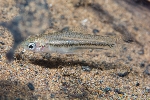The Inheritance of Vertical Barring (Aggression and Appeasement Signals) in the Pygmy Swordtail, Xiphophorus nigrensis (Poeciliidae, Teleostei)
By Zimmerer, Edmund J., Klaus D. Kallman
Copeia, 1988(2):299-307 1988
" The males of the Rio Coy population of Xiphophorus nigrensis, San Luis Potosi, Mexico, exhibit a vertical bar pattern on the flank. During aggressive encounters there is an intensification of the bars as the pigment becomes dispersed throughout the melanophores whereas in submissive individuals the pigment becomes concentrated in the center of the cells and the pattern fades. The Rio Choy population of X. nigrensis, X. pygmaeus and an undescribed species from the Rio Ojo Frio, all in San Luis Potosi, lack this pattern. Within the Rio Coy population there are four size genotypes of males controlled by variation at a Y-linked locus. The pattern is strongly expressed in all males of the three larger size genotypes, but virtually absent from the small size class. In the area of size overlap between the largest males of the genetically small size class and the smallest males of the genetically next larger size class, the expression of the pattern is correlated with genotype not size. The inheritance of the pattern in F, and backcross hybrids with the Choy population and with X. pygmaeus indicates that the trait has a polygenic basis and that the Y chromosome of the Coy stock with the factor for small size has a suppressor gene for bars. The suppressor is absent from all other X and Y chromosomes. Similar patterns are present in 14 of the 19 species of Xiphophorus, and species with and without this trait are found in each of the three major subdivisions of the genus. It is suggested that the pattern has evolved independently in different species "
Classification: Genes and genetics.
Language: English
Reference in bibliography for species (2)
Name substitutions
- Xiphophorus continens referred to as Xiphophorus sp [p. 299].
Zimmerer, Edmund J. & Klaus D. Kallman. 1988. "The Inheritance of Vertical Barring (Aggression and Appeasement Signals) in the Pygmy Swordtail, Xiphophorus nigrensis (Poeciliidae, Teleostei)". Copeia. 1988(2):299-307 (ffm00949) (abstract)

